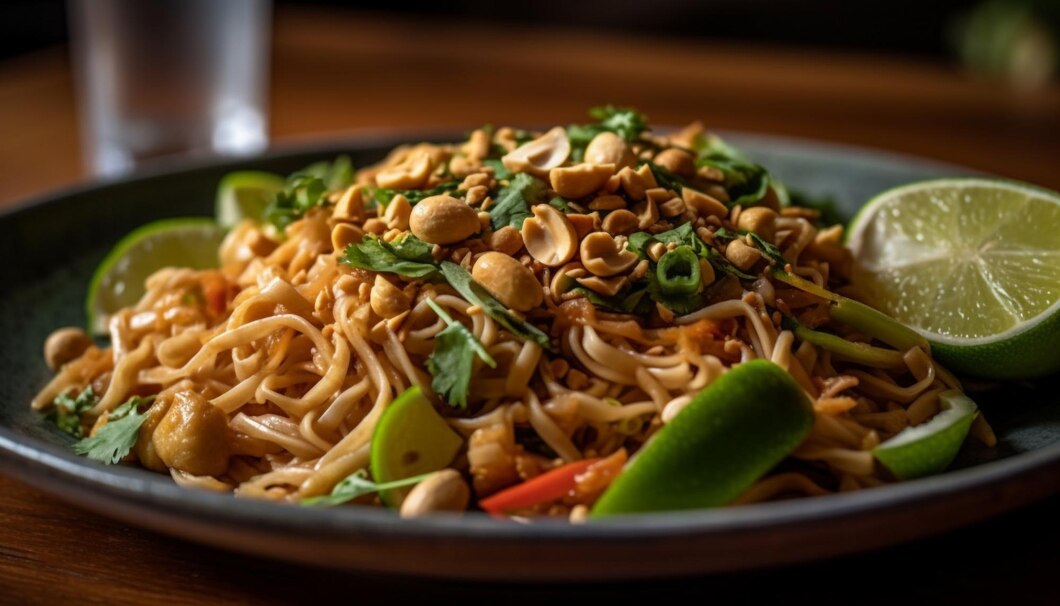Kua Gai Noodles, also known as “Kuay Teow Kua Gai,” is a popular Thai street food dish that has captured the hearts and taste buds of food enthusiasts worldwide. This savory and aromatic dish combines stir-fried rice noodles with tender chicken, vegetables, and a distinctive blend of seasonings, creating a delightful symphony of flavors and textures. Let’s explore the origins, ingredients, preparation, and why Kua Gai Noodles are a must-try for anyone who loves Thai cuisine.
Origins of Kua Gai Noodles
The roots of Kua Gai Noodles can be traced back to the vibrant street food culture of Thailand. While the exact origin of the dish is unclear, it is believed to have emerged from the bustling markets and food stalls of Bangkok, where vendors would cook up quick and flavorful meals for busy locals and tourists. The dish has since become a staple in Thai cuisine, enjoyed both at home and in restaurants.
Ingredients
The magic of Kua Gai Noodles lies in its simplicity and the harmonious blend of ingredients. Here’s what you typically need to make this delicious dish:
- Rice Noodles: Wide rice noodles are preferred for their chewy texture and ability to absorb flavors.
- Chicken: Sliced or diced chicken breast or thigh, marinated to enhance flavor.
- Vegetables: Common choices include Chinese broccoli, bean sprouts, and green onions.
- Eggs: Scrambled into the noodles to add richness.
- Garlic: Finely chopped for a fragrant base.
- Oyster Sauce: Adds depth and umami.
- Soy Sauce: Provides saltiness and color.
- Fish Sauce: Adds a unique savory note.
- White Pepper: For a hint of spice.
- Cooking Oil: Typically vegetable oil, for stir-frying.
Optional ingredients can include mushrooms, tofu, or shrimp, depending on personal preference.
Preparation
Making Kua Gai Noodles is straightforward, making it an excellent choice for a quick and satisfying meal. Here’s a step-by-step guide to preparing this delightful dish:
- Prepare the Ingredients:
- Soak the rice noodles in warm water until they are soft, then drain and set aside.
- Marinate the chicken with a bit of soy sauce and white pepper.
- Chop the vegetables and garlic.
- Cook the Chicken:
- Heat a wok or large skillet over medium-high heat and add a splash of oil.
- Add the garlic and sauté until fragrant.
- Add the marinated chicken and stir-fry until it is cooked through.
- Add the Noodles and Vegetables:
- Push the chicken to one side of the wok and add a little more oil if needed.
- Add the rice noodles and stir-fry for a couple of minutes.
- Mix in the vegetables and continue to stir-fry until they are just tender.
- Incorporate the Eggs:
- Push the noodles and chicken to the side and crack the eggs into the wok.
- Scramble the eggs until they are mostly cooked, then mix them into the noodle mixture.
- Season and Serve:
- Add oyster sauce, soy sauce, and fish sauce to taste, and mix well to coat the noodles evenly.
- Stir-fry everything together for another minute to ensure the flavors are well combined.
- Serve hot, garnished with fresh green onions or cilantro if desired.
Why Kua Gai Noodles Are a Must-Try
- Flavor Explosion: The combination of savory sauces, tender chicken, and fresh vegetables creates a mouthwatering flavor profile that is both comforting and exciting.
- Texture Variety: The chewiness of the rice noodles, the tenderness of the chicken, and the crunchiness of the vegetables provide a delightful mix of textures in every bite.
- Versatility: Kua Gai Noodles can be customized with various proteins and vegetables, making it adaptable to different tastes and dietary preferences.
- Quick and Easy: The dish is relatively simple to prepare, making it an excellent choice for a weeknight dinner or a quick lunch.
- Authentic Thai Experience: Enjoying Kua Gai Noodles is like taking a culinary trip to Thailand, offering an authentic taste of the country’s rich street food culture.
Conclusion
Kua Gai Noodles are a delicious representation of Thai street food that combines simple ingredients with bold flavors and delightful textures. Whether you’re a seasoned Thai food lover or new to the cuisine, this dish is sure to impress and satisfy. So, next time you’re looking for a quick and tasty meal, try making Kua Gai Noodles and experience the magic of Thai street food right in your own kitchen.










